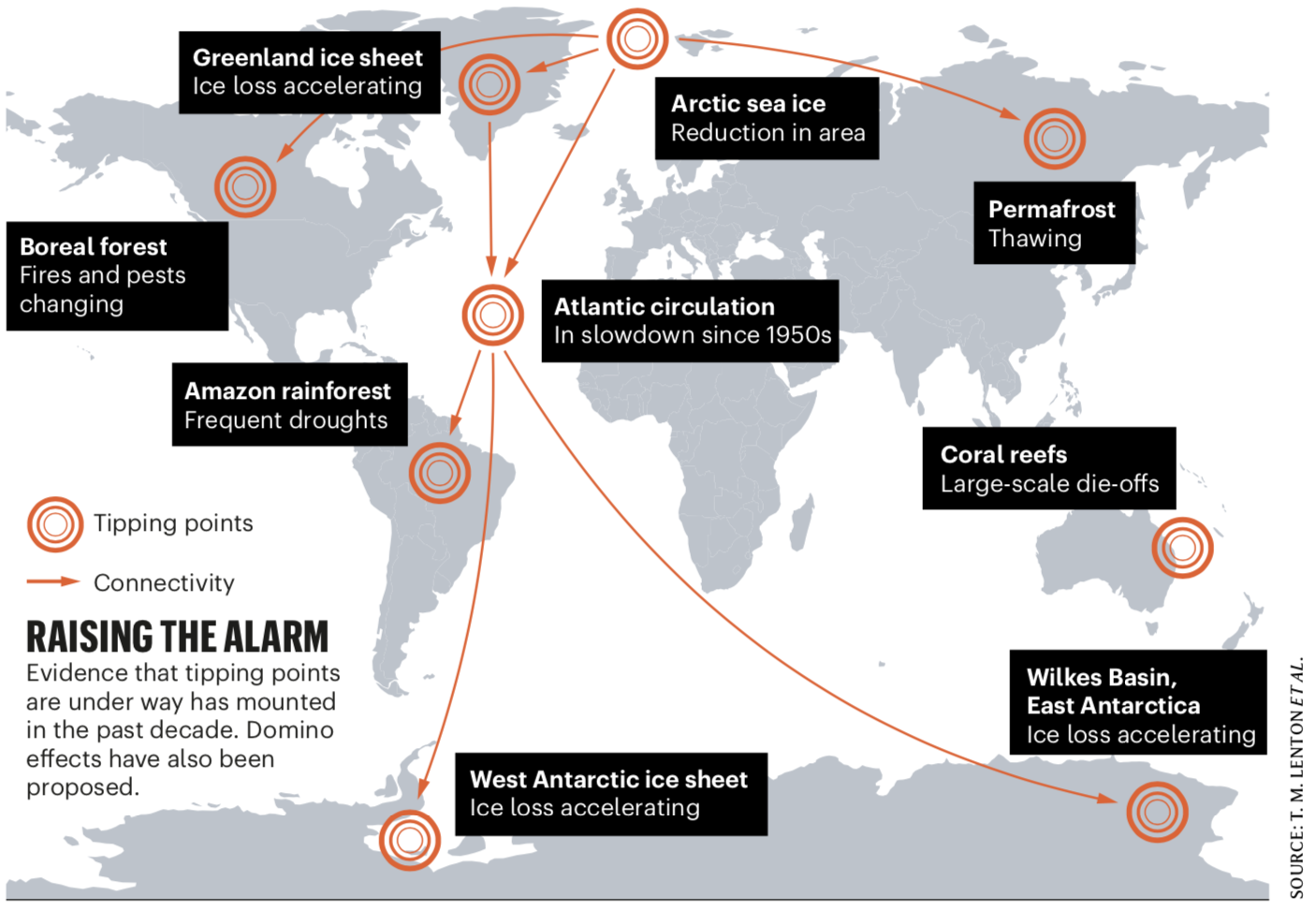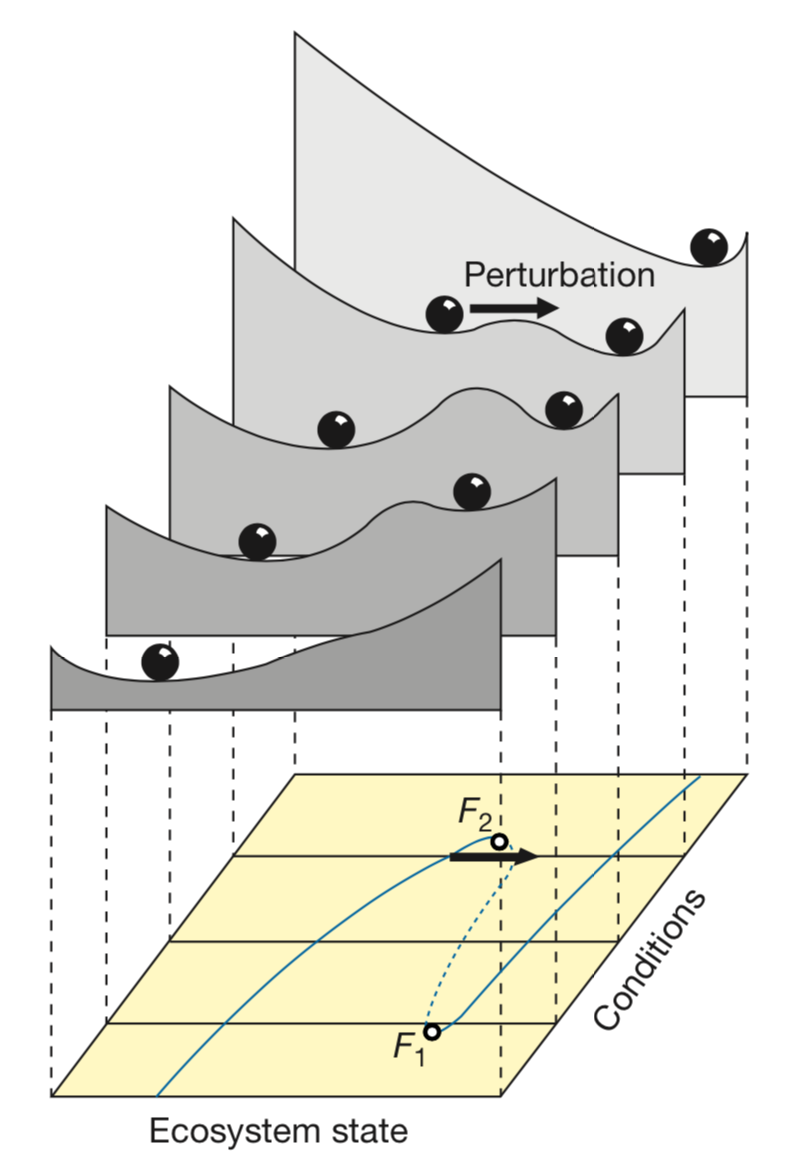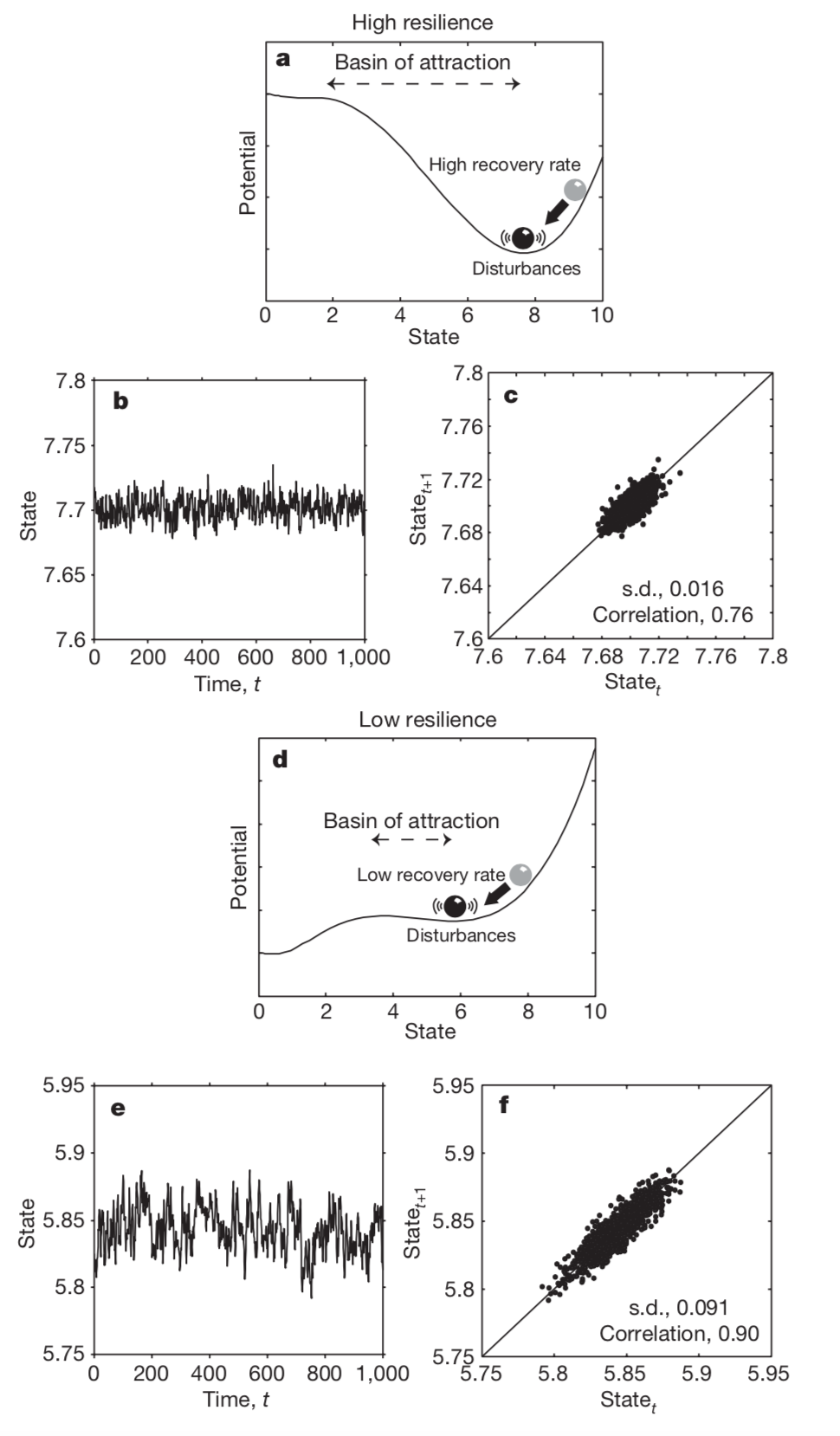
Interactions and early warnings



Outline
Tipping interactions & cascades
Detection in data
Earth stewardship
Tipping points can interact
Interactions
Amazon tipping points: 3-4∘C, 1500mm rain, 40% deforestation, fire frequency?

Which will be hit first? How approaching one modifies another?
Forest to savanna
Regime shifts are large, abrupt and persistence critical transitions in the function and structure of (eco)systems
Coral transitions
Regime shifts are large, abrupt and persistence critical transitions in the function and structure of (eco)systems
Fisheries collapse
Regime shifts are large, abrupt and persistence critical transitions in the function and structure of (eco)systems
Can regime shifts be interconnected?
How crossing a tipping point could increase the likelihood of other ecosystems tipping over
How do regime shifts interact?

Whether the occurrence of one will increase the likelihood of another, or simply correlate at distant places
Conceptual and theoretical work
- Tipping can hop between systems: X→Y→Z
Brummit 2015 - Coupled tipping systems do not leave early warning signals Dekker 2018
- Some network motifs (feedforward loops) can destabilize tipping cascades Krönke 2020, Wunderling 2020
Modelling and climate centered work. Are there other mechanisms?
Regime Shifts Database
- To provide a high quality synthesis of different types of regime shifts in SES
- To facilitate comparison
- Focus: regime shifts that have large impacts on ecosystem services i.e. matter to people
- Target audience: Scientist, assessment processes, educators, practitioners, policy-makers

Source: Regime Shifts Database
Method

Rocha, J, et al . Cascading regime shifts within and across scales. Science 362, 1379–1383 (2018)
A worked example

Cascading effects

~45% of the regime shift couplings analyzed present structural dependencies in the form of one-way interactions for the domino effect or two-way interactions for hidden feedbacks
Driver sharing

Aquatic regime shifts tend to have and share more drivers. The most co-occurring drivers are related to food production, climate change & urbanisation. 36% of pair-wise combinations are solely coupled by sharing drivers
Domino effects

Evidence of cross-scale interactions for domino effects was only found in space but not in time. The maximum number of pathways found was 4, and the variables that produce most domino effects relate to climate, nutrients and water transport
Hidden feedbacks

Most hidden feedbacks occur in terrestrial and earth systems. Key variables that belong to many of these hidden feedbacks are related to climate, fires, erosion, agriculture and urbanisation
Trivia
What is your favorite take home message from their work?
05:00
Why does it matter? Earth Stewardship

Who has the agency to make a difference?

- “Zoonotic EID risk is elevated in forested tropical regions experiencing land-use changes and where wildlife biodiversity is high” Allen et al 2017
- Companies who extract natural resources
- Shareholders who invested in them
- Networks of shareholders with common investments
Why does it matter? Earth Stewardship
- How tipping points are interconnected can amplify or dampen cascading effects: network structure matters
- It can empower countries, cities or businesses to do their part: emphasize agency
- It can re-draw the geopolitical map of the world: with whom do you need to cooperate to avoid synchronous crises?
Regime shifts can be interconnected
- Climate is a central mechanism, but not the only one. Other mechanisms can trigger tipping cascades earlier than climate
- Multiple mechanisms means multiple opportunities for intervention
- Empirical evidence is missing: which connections are more relevant? what interventions has potential to slow down tipping cascades?
Where on Earth are regime shifts likely to occur?
Depends on our ability to observe and measure resilience
Regime shifts and resilience
- Size of the basin of attraction
- Depth
- Slope
- Proximity to the boundary
- Property of the system or the regime (state variable)?
- Property of the disturbance?
- Resilience of what to what?
Clark, W 1975 IIASA
Menck et al 2013 NatPhys
Carpenter et al 2001 Ecosystems
Back to theory
d🐠d⏱️=🐠(1−🐠🌎)−🎣(🐠2🐠2+1)


Where is the tipping point?
Resilience indicators

Resilience indicators
- ↑ Variance and autocorrelation
- Δ skewness and kurtosis
- Model-based indicators:
- Diffusion jump models
- Time varying AR(p) models
- Threshold AR(p) models
- Potential analysis
- Spatial indicators:
- Fourier transforms
- Power spectrum
- Patch-size distributions
Critical slowing down
- Variance and autocorrelation
- NDVI: normalized difference vegetation index
- VOD: vegetation optical depth
- Limited spatial and temporal resolution
- Confirm a threshold: 1500mm
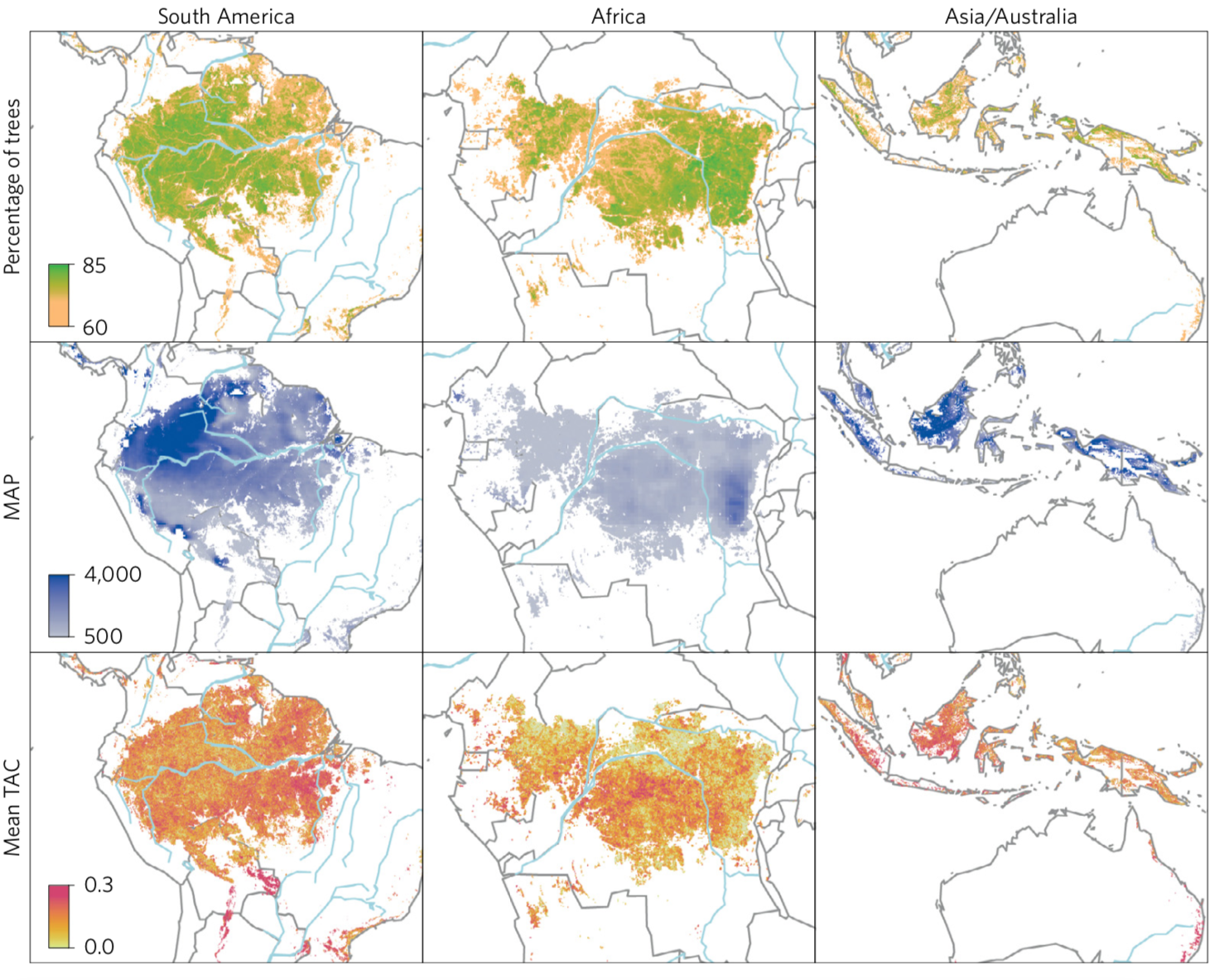
Verbesselt J, et al. Remotely sensed resilience of tropical forests. 2016.
Limitations: fail when dynamics are driven by stochastic processes or when signals have too much noise
Resilience indicators
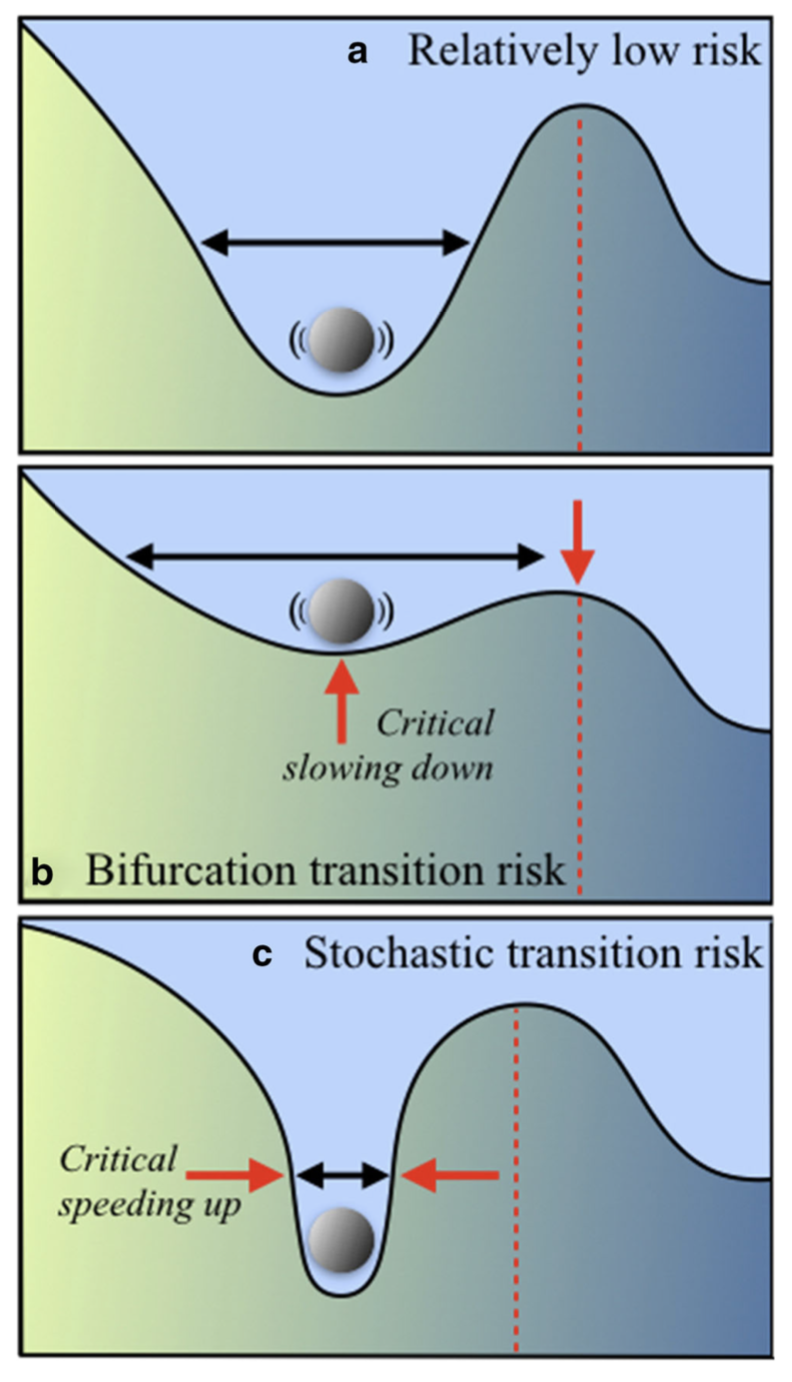
Resilience indicators
- ↑ adaptive capacity
- Measure of self-similarity across scales
- Fractal geometry:
- Bounded
- Magnitudes do not depend on scale
- Clear interpretation
- Applications in medicine
West, Bruce. 2010. Frontiers Physiology
Gneiting et al. 2012. Statistical Science.
Data & methods
- ↑ Variance and autocorrelation
- Δ skewness and kurtosis
Dakos et al. 2012. PLoS ONE
Kéfi et al. 2014. PLoS ONE
- ↓ Variance and autocorrelation
Titus & Watson 2020 J Theor Ecol
Fractal dimension
- ↑ adaptive capacity
- Measure of self-similarity across scales
West, Geoffrey. 2017. Scale
Gneiting et al. 2012. Statistical Science.
- Terrestrial:
- Gross primary productivity (2001:2018)
- Ecosystem respiration (2001:2018)
- Leaf area index (1994:2017)
- Marine:
- Chlorophyll A (1998:2018)
- >1M pixels, weekly obs, 0.25 degree grid resolution
Analysis: one pixel
![]()
The generic resilience indicators do not necessarily align with critical slowing down or speeding up theories
Detection

In the absence of ground truth, if Δ is > 95% or < 5% of the distribution is considered a signal of resilience loss
Gross primary productivity 
~30% of ecosystem show symptoms of resilience loss, boreal forest and tundra particularly strong signals
Chlorophyll A 
~25% of ecosystem show symptoms of resilience loss, Easter Indo-Pacific and Tropical Eastern Pacific Oceans particularly strong signals
Next steps
- Identify who has agency to make a difference
- Identify if the symptoms in one place are related to symptoms elsewhere: empirical evidence of cascading effects
- Use the network structure to manage and avoid escalating crises
Summary
- Regime shifts are large, abrupt and persistent changes
- They occur when tipping points are crossed
- Tipping points can interact
- Regime shifts can be interconnected
- Identifying where, when and by whom can help us manage their risk: cities, businesses, everyone! have an important role to play in taking care of 🌎
Tack | Gracias
Questions?
email: juan.rocha@su.se
twitter: @juanrocha
slides: juanrocha.se/presentations/interacting_tipping
Terrestrial ecosystem respiration 
~30% of ecosystem show symptoms of resilience loss, boreal forest and tundra particularly strong signals



